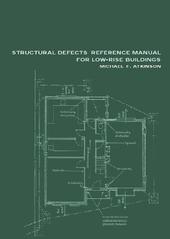
|
Structural Defects Reference Manual for Low-Rise Buildings
Paperback / softback
Main Details
| Title |
Structural Defects Reference Manual for Low-Rise Buildings
|
| Authors and Contributors |
By (author) Michael F. Atkinson
|
| Physical Properties |
| Format:Paperback / softback | | Pages:240 | | Dimensions(mm): Height 298,Width 210 |
|
| Category/Genre | Structural engineering |
|---|
| ISBN/Barcode |
9780419257905
|
| Classifications | Dewey:624.171 |
|---|
| Audience | | Further/Higher Education | | Professional & Vocational | | Technical / Manuals | |
|---|
| Illustrations |
50 Tables, black and white
|
|
Publishing Details |
| Publisher |
Taylor & Francis Ltd
|
| Imprint |
Spon Press
|
| Publication Date |
29 June 2000 |
| Publication Country |
United Kingdom
|
Description
When a building suffers structural damage, the causes of that damage have to be properly identified before any remedial work can be undertaken. The Structural Defects Reference Manual for Low-Rise Buildings has been written to assist professionals and students involved in building construction to identify causes of structural failure. Each chapter carefully addresses design, materials and workmanship factors which contribute to structural defects. The main structural elements - roof, walls, floors and foundations - are all covered and illustrated by case studies. The book also contains relevant data and guidance to show how all the different building elements should be designed and constructed. This practical reference manual will be an invaluable guide for surveyors, engineers, loss adjusters, students of construction and anyone else concerned with structural defects in low-rise buildings.
Author Biography
Michael F. Atkinson is a highly experienced civil and structural engineer, and has been Engineering Manager for the National House Building Council (North) since 1984. A Fellow of the Institute of Structural Engineers and a Member of the Institute of Civil Engineers, he has over forty-two years' experience in the construction industry.
Reviews'A practical reference manual and guide for surveyors, engineers and loss adjustors.' Current Engineering Practice 2001
|